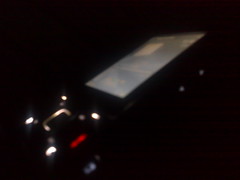Simple Improvements To Complex Devices

It's night, and you hear your N81 8GB chime that the battery is low. Uh oh, forgot to plug it in to the charger. The lights are off, so it's pitch dark and you really don't want to turn on the lights just to see where that tiny little prong plugs in on the phone. So you fumble around with the charger and phone until you finally connect...
Why is there lights for every single button on phones these days, but there's no way to see where various connectors are when you need to plug in? I know it sounds trivial to have such a feature on a mobile device, or any device for that matter, but there are a lot of us that live our lives in the darkness a large percent of the time and we need well lit icons, terminal beacons, and just about anything that helps us even just a little bit while in less than acceptable lighting conditions.
In a time where Timex Indiglo watches, writing pens with battery powered LEDs, and ultra low power plug-in night lights exist, it only makes sense that the devices we use 24/7 should be user friendly 24/7. With the addition to status LEDs, backlit buttons and keys, and even battery indicator lights, it's only logical to have a way to see where those ever shrinking plugs go while in the dark. Be it through a dedicated "light up the sockets" button or some other ingenious method.
Of course it would be great if you could turn the feature off to save power or for those that never really need it. I mean it's not like you would need the lights on all the time anyways, so why not just let the light sensors on these devices determine when it's too dark and turn on when you hit one of the buttons on the device? This brings me to another simple idea of static awareness of devices where your device should know when it's been touched or moved and will react according to what the user wants to happen, but I'll save that for another post.
"In the right light, at the right time, everything is extraordinary."



1 Comments:
Login S128 -> http://logins128.blogspot.com
Sabung Ayam S128 -> http://daftarsabungayams128.blogspot.com
Daftar Akun S128 -> http://daftarakuns128.blogspot.com
Sabung Ayam Indonesia -> http://situssabungayamindonesia.blogspot.com
Sabung Ayam Terbaik -> http://situssabungayamterbaik.blogspot.com
Sabung Ayam Terbaru -> http://situssabungayamterbaru.blogspot.com
Sabung Ayam Terpercaya -> http://situssabungayamterpercaya.blogspot.com
Judi Sabung Ayam -> http://daftarjudisabungayamonline.blogspot.com
Daftar Sabung Ayam -> http://daftarsabungayamterpercaya.blogspot.com
Sabung Ayam Online -> http://sabungayamonline2017.blogspot.com
Post a Comment
<< Home